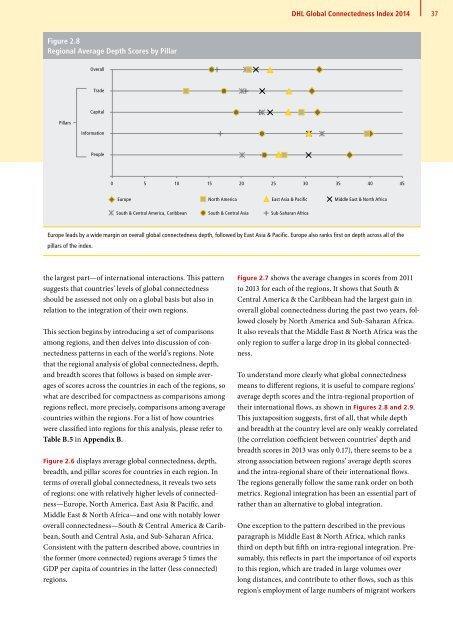DHL Global Connectedness Index 2014
DHL Global Connectedness Index 2014
DHL Global Connectedness Index 2014
- No tags were found...
Create successful ePaper yourself
Turn your PDF publications into a flip-book with our unique Google optimized e-Paper software.
<strong>DHL</strong> <strong>Global</strong> <strong>Connectedness</strong> <strong>Index</strong> <strong>2014</strong><br />
37<br />
Figure 2.8<br />
Regional Average Depth Scores by Pillar<br />
Overall<br />
Trade<br />
Pillars<br />
Capital<br />
Information<br />
People<br />
0 5 10 15 20 25 30 35 40 45<br />
Europe North America East Asia & Pacific Middle East & North Africa<br />
South & Central America, Caribbean South & Central Asia Sub-Saharan Africa<br />
Europe leads by a wide margin on overall global connectedness depth, followed by East Asia & Pacific. Europe also ranks first on depth across all of the<br />
pillars of the index.<br />
the largest part—of international interactions. This pattern<br />
suggests that countries’ levels of global connectedness<br />
should be assessed not only on a global basis but also in<br />
relation to the integration of their own regions.<br />
This section begins by introducing a set of comparisons<br />
among regions, and then delves into discussion of connectedness<br />
patterns in each of the world’s regions. Note<br />
that the regional analysis of global connectedness, depth,<br />
and breadth scores that follows is based on simple averages<br />
of scores across the countries in each of the regions, so<br />
what are described for compactness as comparisons among<br />
regions reflect, more precisely, comparisons among average<br />
countries within the regions. For a list of how countries<br />
were classified into regions for this analysis, please refer to<br />
Table B.5 in Appendix B.<br />
Figure 2.6 displays average global connectedness, depth,<br />
breadth, and pillar scores for countries in each region. In<br />
terms of overall global connectedness, it reveals two sets<br />
of regions: one with relatively higher levels of connectedness—Europe,<br />
North America, East Asia & Pacific, and<br />
Middle East & North Africa—and one with notably lower<br />
overall connectedness—South & Central America & Caribbean,<br />
South and Central Asia, and Sub-Saharan Africa.<br />
Consistent with the pattern described above, countries in<br />
the former (more connected) regions average 5 times the<br />
GDP per capita of countries in the latter (less connected)<br />
regions.<br />
Figure 2.7 shows the average changes in scores from 2011<br />
to 2013 for each of the regions. It shows that South &<br />
Central America & the Caribbean had the largest gain in<br />
overall global connectedness during the past two years, followed<br />
closely by North America and Sub-Saharan Africa.<br />
It also reveals that the Middle East & North Africa was the<br />
only region to suffer a large drop in its global connectedness.<br />
To understand more clearly what global connectedness<br />
means to different regions, it is useful to compare regions’<br />
average depth scores and the intra-regional proportion of<br />
their international flows, as shown in Figures 2.8 and 2.9.<br />
This juxtaposition suggests, first of all, that while depth<br />
and breadth at the country level are only weakly correlated<br />
(the correlation coefficient between countries’ depth and<br />
breadth scores in 2013 was only 0.17), there seems to be a<br />
strong association between regions’ average depth scores<br />
and the intra-regional share of their international flows.<br />
The regions generally follow the same rank order on both<br />
metrics. Regional integration has been an essential part of<br />
rather than an alternative to global integration.<br />
One exception to the pattern described in the previous<br />
paragraph is Middle East & North Africa, which ranks<br />
third on depth but fifth on intra-regional integration. Presumably,<br />
this reflects in part the importance of oil exports<br />
to this region, which are traded in large volumes over<br />
long distances, and contribute to other flows, such as this<br />
region’s employment of large numbers of migrant workers





